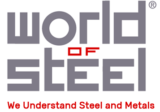EUROPE STEEL SCRAP SPECIFICATION
“GRADE” IS A CLASSIFICATION OF SCRAP TYPE BASED UPON INSTITUTE OF SCRAP RECYCLING INDUSTRIES (ISRI) FERROUS SCRAP CLASSIFICATION.
- applicable size limitations
- applicable requirements for the type of scrap
- applicable requirement with respect to the scrap quality
EUROPE STEEL SCRAP SPECIFICATION:
Category | Specification | Description | Dimensions | Density | Sterile |
OLD SCRAP | E 3 | Old thick steel scrap, predominantly mare than 6mm thick in sizes not exceeding 1.5x0.5x0.5m prepared in a manner to ensure direct charging. May include tubes and hollow sections Excludes vehicle body scrap and wheels from light vehicles. | Thickness >=6mm <1.5x0.5xO.5in | >= 0.6 | <= 1% |
OLD SCRAP | E 1 | Old thin steel scrap predominantly less than 6mm thick in sizes not exceeding 1.5x0.5x0.5 in prepared in a manner to ensure direct Charging. If greater density is required it is recommended that maximum 1 metre is specified. May include light vehicle wheels, but must exclude vehicle body scrap and domestic appliances. Must be free of rebars and merchant bars_ free of metallic copper, tin, lead (and alloys), mechanical pieces and steriles to meet the aimed analytical contents. | Thickness > 6mm <1.5x0.5x0.5m | >= 0.5 | < 1.5% |
New Scrap Low Residuals,Uncoated | E 2 | Thick new production steel scrap predominantly more than 3mm thick prepared in a manner to ensure direct charging. The steel scrap must be uncoated unless permitted by joint agreement and be free of rebars and merchant bars even from new production. Must be free of metallic copper, tin, lead (and alloys), mechanical pieces and steriles to meet the aimed analytical contents. | Thickness >= 3mm <1.5x0.5 0.5m | >= 0.6 | < 0.3% |
New Scrap Low Residuals,Uncoated | E 8 | Thin new production steel scrap predominantly less than 3mm thick prepared in a manner to ensure direct charging. The steel scrap must be uncoated unless permitted by joint agreement and be free of unbound ribbons to avoid trouble when charging. Must be free of metallic copper, tin lead (and alloys), mechanical pieces and steriles to meet the aimed analytical contents. | Thickness >= 6mm <1.5x0.5 0.5m | >= 0.4 | < 0.3% |
New Scrap Low Residuals,Uncoated | E 6 | New production thin steel scrap (less than 3mm thick) compressed or firmly baled in a manner to ensure direct charging. The steel scrap must be uncoated unless permitted by joint agreement. Must be free of metallic copper, tin, lead (and alloys), mechanical pieces and steriles to meet the aimed analytical contents. | >= 1 | < 0.3% | |
Shredded | E 40 | Shredded steel scrap_ Old steel scrap fragmentized into pieces not exceeding 200mm in any direction for 95% of the load. No piece, in the remaining 5%, shall exceed 1000mm. Should be prepared in a manner to ensure direct charging. The scrap shall be free of excessive moisture, loose cast iron and incinerator material (especially tin cans). Must be free of metallic copper, tin„ lead (and alloys), and steriles to meet the aimed analytical contents | > 0.9 | < 0.4% | |
Steel Turnings | E 5 H | Homogeneous lots of carbon steel turnings of known origin, free from excessive bushy. Should be prepared in a manner to ensure direct charging. Turnings from Free Cutting Steel must be clearly identified. The turnings must be free from all contaminant such as non ferrous metals, scale, grinding dust and heavily oxidized turnings or other materials from chemical industries. Prior chemical analysis could be required. | |||
Steel Turnings | E 5 M | Mixed lots of carbon steel turnings, free from excessive bushy and free from turnings from Free Cutting Steel Should be prepared in a manner to ensure direct charging. The turnings must be free from all contaminants such as non ferrous metals, scale grinding dust and heavily oxidized turnings or other materials from chemical industries. | |||
High Residual Scrap | EHRB (4) | Old and new steel scrap consisting mainly of rebars and merchant bars prepared in a manner to ensure direct charging. May be cut, sheared or baled and must be free of excessive concrete or other construction material Must be free of metallic copper, tin, lead (and alloys), mechanical pieces and steriles to meet the aimed analytical content. | Max 1.5x0.5x0.5 m | >= 0.5 | < 1.5% |
High Residual Scrap | EHRM (5) | Old and new mechanical pieces and components not accepted in the other grades prepared in a manner to ensure direct charging. May include cast iron pieces (mainly the housings of the mechanical components). Must be free of metallic copper, tin, lead (and alloys) & pieces such as bearing shells, bronze rings and others as well as steriles, to meet the aimed analytical contents | Max 1.5x0.5x0.5 m | >= 0.6 | < 0.7% |
Fragmentized Scrap from Incineration | E 46 | Fragmentized incinerator scrap. Loose steel scrap processed through an incinerating plant for household waste followed by magnetic separation, fragmentized into pieces not exceeding 200mm in any direction and consisting partly of tin coated steel cans. Should be prepared in a manner to ensure direct charging. The scrap shall be free of excessive moisture and rust Must be free of excessive metallic copper, tin, lead (and alloys) and steriles to meet the aimed analytical contents | >= 0.8 | Fe Content >= 92% |
